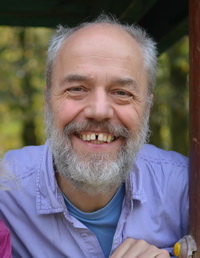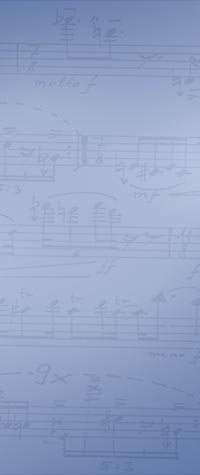
Matěj Kratochvíl:
Gesamtkunstwerk on ice
Czech Music 1/2004, p. 19-20
"I've got some quite big opera plans as well" - That was how Martin Smolka ended an interview with us two years ago (Czech Music 12/2001), but nobody could have dreamed just what sort of plans they were. It was not until about six months ago that the opera, already in the final stages of preparation, became a sensational topic provoking all kinds of speculation. The dailies and weeklies all carried reports, although these rarely mentioned the name of the composer let alone the kind of music that could be expected. With all the press massage all sorts of questions were raised that couldn't really be answered until the premiere.
It is a piece in which the rules of opera are combined with the rules of ice hockey, and both are broken. Each third has a different form. The first third is reminiscent of a rondo, with preparations for the arrival of the hockey god "Hasan" [Dominik Hasek - the biggest Czech hockey star] against the background of the hectic rush of the dressing room and gym. The second is divided into three matches with the USA, Canada and Russia respectively, each of them narrated in a different way. The most notable is the semi-final with Canada, with only the extra time presented and the assaults on the goal becoming the impulses for variously conceived combats (danced and sung). The last third of the opera is the Olympic ceremony with an inserted dream about Hasek ascending to the castle as president. The action has a commentator in the form of Milan Hnilicka, a goalkeeper substitute who didn't ever actually get to go on the ice at the Olympics. He himself is the object of commentary by his parents, who sit in front of the TV in the back of the stage throughout the performance.
Anyone who has followed Smolka's output in recent years will discover that several different approaches that have lately crystallised in his work are combined in Nagano. There are rhythmically striking passages deriving from Minimalism, but a fondness for bizarre and out-of-tune noises at odds with the purity and rhythmic precision of the American composers (one of the most frequently played of Smolka's pieces - Euforium - may serve as a prototype here). The chanting of the fans and the panting of the players in the gym are a source of inspiration for rhythmic models - Smolka uses these "tunes" to create complex polyrhythmic constructions. They are so interwoven that at a first listening one does not hear the occasional imperfections of orchestral play, and the composer may even have reckoned with a certain imperfection, although in recent years he has been "spoilt" by the frequent performance of his works by top foreign musicians.
The second stylistic approach is almost romantically tranquil - for example in Jagr's duet with the ice, Hnilicka's scene with a Japanese woman fan or the final departure of the heroes for their homeland. Although this might seem a matter of parody and mickey-taking, lyricism has been a natural part of Smolka's expressive repertoire since the 1980 (Slzy [Tears], Hudba hudbicka [Music, Sweet Music]) and is to be found in his more recent work as well (Walden).
The third element consists of citations or references to various different styles: when the hockey go Hasek is raised up on high we here a distorted fanfare from Also Sprach Zarathustra, and the following Shamanic Dance evokes a coupling of The Rite of Spring and Jesus Christ Superstar. At the defeat of the Russian team a dumka (contemplative elegy) in emerges in tremolo strings, and when Svejk appears on the stage he is accompanied by suggestions of brass band music.
Opera singers are not usually much inclined to horseplay and experiments, but the subject and perhaps the charisma of the authors brought out the playfulness in the soloists. The hockey players really enjoyed their roles and didn't seem forced or affected, even in the gym scene. Milan Hnilicka (Vaclav Sibera) and the trainer (Ludek Vele) are both excellent, but the other soloists don't lag behind. The demands placed on them are substantially greater than in some romantic piece and they have to cope as dancers as well as singers. Jan Mikusek's Dominik Hasek deserves a special mention. The authors interpreted the modern slogan "Hasek is god" in their own way, creating a hybrid of an ancient god from Baroque opera and a Japanese samurai. The slight figure (in contrast to the expansive dimensions of the other players) sings counter tenor Latin declamations and really looks more like help from above than a member of the team. Singing "Coeli coelorum" he goes into combat like David against the huge Goliath of the Canadian striker with his "Hell, go to hell". Ondrej Havelka was an unknown quantity as a trained but not a practising opera director. This made it all the more of a pleasant surprise to find that he had been able to contribute his own view and many effective ideas to the material by Smolka and Dusek's. Martin Vrany's choreography is also a striking element. The engagement of someone from the modern dance sphere was one of many good choices. The combination of break dance, martial arts and modern expressive techniques has the lion's share particularly in the matches in the second act (Tomas Vesely, the dance double of Dominik Hasek deserves special praise). Nagano is a spectacle in which there is always something to watch and something to laugh at. Some people argue that this will help audiences to accept music that would otherwise be too complicated for them. Others think it that it draws attention away from the music and so it actually doesn't matter what sort of music is accompanying the show. In some of the reviews appearing just after the premiere it was suggested that the music keeps in the background of the production, but while there is certainly plenty happening on the stage, in my view the music definitely does not hang back in the wings. Without the music or with different music the whole spectacle would lose its point. It is obvious that all four main authors of the piece must have worked very closely from the start and many of the good ideas derive precisely from the interplay of all the elements. If we want to demonstrate the concept of "gesamtkunstwerk", Nagano can serve as a good example.
COPYRIGHT 2004 Czech Music Information







